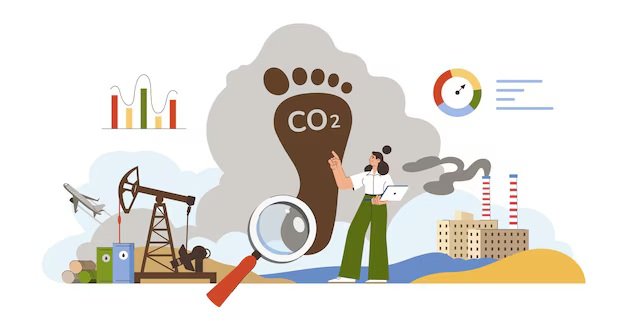What is a Carbon Footprint?
Imagine this: You wake up, stretch, and head to the kitchen to brew a fresh cup of coffee. The aroma fills the air as you pour it into your favourite mug. Then, you grab your keys, start your car, and head to work. These small, everyday actions seem routine, but they all contribute to something bigger: your carbon footprint.
Every choice we make—what we eat, how we get around, the energy we use—adds up. The electricity powering your coffee maker, the gas in your car, even the production of the mug in your hand, required energy and resources, releasing carbon dioxide (CO₂) and other greenhouse gases (GHGs) into the atmosphere. These gases trap heat, driving climate change, extreme weather, and environmental shifts we can no longer ignore.
Think of your carbon footprint as an invisible trail left behind by everything you do. Some people have a larger footprint due to frequent flying, meat-heavy diets, or energy-intensive lifestyles. Others, through conscious choices, keep their impact lower. The good news? You have control over your footprint, and small changes can make a big difference.

In This Article
- What is a Carbon Footprint?
- Why Should You Care About Your Carbon Footprint?
- True Stories: Personal Journeys in Carbon Reduction
- Interactive Case Study: Compare Your Carbon Footprint
- Actionable Steps: How to Reduce Your Carbon Footprint
- Conclusion
What is a Carbon Footprint?
A carbon footprint is the total amount of greenhouse gases, especially CO₂, that a person, product, or organisation emits directly or indirectly. It includes:
- Direct emissions: The fuel burned in your car or gas stove.
- Indirect emissions: The resources used to produce your food, clothes, and gadgets.
The term “carbon footprint” was coined in the early 2000s by William Rees and Mathis Wackernagel, who introduced the ecological footprint concept. Today, it’s a crucial part of the global conversation on climate change—and understanding yours is the first step toward reducing it.
Why Should You Care About Your Carbon Footprint?
Climate change is no longer a distant threat—it’s happening now. Rising global temperatures, extreme weather events, and shrinking polar ice caps all have direct consequences on ecosystems, economies, and human lives. According to the Intergovernmental Panel on Climate Change (IPCC), human activities have caused approximately 1.1°C of global warming above pre-industrial levels.
Understanding and reducing your carbon footprint is one of the most impactful ways you can contribute to climate solutions. By making conscious choices, you help protect the planet for future generations while also improving your own quality of life through cost savings and healthier living.
Breaking Down the Carbon Footprint: Major Contributors
A person’s carbon footprint can be broken down into several key areas:
- Transportation
- Personal Vehicles: Driving a gasoline-powered car contributes significantly to individual carbon footprints. In the United States, transportation is one of the largest sources of greenhouse gas emissions, primarily from burning fossil fuels for cars, trucks, ships, trains, and planes.
- Air Travel: Air travel is a significant contributor to carbon emissions. For example, a round-trip flight from New York to London generates about 986 kg (approximately 1 metric ton) of CO₂ per passenger, according to the EPA.
- Alternatives: Opting for public transportation, biking, or walking can substantially reduce your transportation-related emissions. Additionally, the adoption of electric vehicles, which produce fewer emissions than traditional gasoline-powered cars, is on the rise.
- Food and Diet
- Dietary Choices: A meat-heavy diet produces significantly more emissions than a plant-based diet. The production of meat, especially beef, requires large amounts of feed, land, and energy, leading to higher greenhouse gas emissions.
- Food Waste: Globally, about 1.3 billion tons of food are wasted each year, contributing to 8-10% of global greenhouse gas emissions. Food production emissions consist mainly of CO₂, N₂O, and CH₄, which result primarily from agricultural practices.
- Energy Use at Home
- Electricity Consumption: The average household emits a significant amount of CO₂ annually from electricity use alone. In the United States, the largest source of greenhouse gas emissions from human activities is from burning fossil fuels for electricity, heat, and transportation.
- Energy Efficiency: Implementing energy-efficient appliances, improving home insulation, and switching to renewable energy sources can significantly reduce these emissions. For instance, electricity and heat production are the largest contributors to global emissions
- Consumer Goods and Waste
- Product Lifecycle: Every item you purchase—clothes, electronics, furniture—has a carbon footprint based on its production, transportation, and disposal. The manufacturing and construction sectors are significant contributors to global greenhouse gas emissions.
- Fast Fashion: The fashion industry, particularly fast fashion, is a notable contributor to carbon emissions. The production of textiles requires energy and resources, leading to substantial greenhouse gas emissions.
Learn More: What was the Environmental Impact of the Industrial Revolution?
True Stories: Personal Journeys in Carbon Reduction
Dirk’s Commitment to Environmental Accountability
Dirk Gratzel, a software entrepreneur from Germany, experienced a profound realisation about his environmental impact. Immersed in nature through his hobbies, he became increasingly aware of the environmental degradation around him. This awareness led him to take a bold step: calculating his lifetime carbon emissions. The results were staggering—his annual emissions amounted to 27 metric tons of CO₂, more than twice the German average of 11 tons. This eye-opening discovery propelled Dirk to embark on a mission to reduce his carbon footprint. He made significant lifestyle changes, including:
- Transportation: He eliminated air travel, opting for trains and bicycles instead.
- Diet: He adopted a plant-based diet, significantly reducing his food-related emissions.
- Energy Efficiency: He enhanced the insulation of his 18th-century home to minimise heating requirements.
Through these concerted efforts, Dirk successfully reduced his annual emissions to approximately 6 or 7 metric tons, marking a substantial decrease in his carbon footprint.
Jacqueline and Andrew’s Sustainable Transformation
Retired couple Jacqueline and Andrew Davidson from Ayr, Scotland, transformed their lifestyle out of concern for their environmental impact. In 2022, they transitioned to sustainable energy sources, including:
- Renewable Energy: Installing solar panels and battery storage systems.
- Heating: Implementing a heat pump to replace traditional heating methods.
These changes led to a remarkable 57% reduction in their grid energy usage, decreasing their monthly energy expenditure from £336 to £100 and resulting in nearly £3,000 in annual savings. Their home’s energy performance rating improved from C to A, demonstrating the effectiveness of their eco-friendly modifications.
Héloïse’s Eco-Friendly Travel Initiative
In France, companies are encouraging employees to adopt sustainable travel habits. Héloïse Arnold, an employee at Vendredi, utilised an extra “responsible travel time” day provided by her employer to take a vacation to Scotland by train. This initiative encourages eco-friendly travel by offering additional vacation days for long journeys exceeding six hours, whether by train, bus, carpool, or bicycle. Vendredi reports that one in three employees has utilised this program, significantly reducing their carbon footprints.
Zizou’s Advocacy for Sustainable Sports
Belgian tennis player Zizou Bergs is ascending in the ATP rankings but grapples with the environmental impact of his extensive travel. As an advocate for sustainability, Bergs is committed to reducing his carbon footprint, aligning with the ATP Tour’s goal of a 50% emission reduction by 2030. His eco-friendly initiatives include:
- Sustainable Practices: Extended use of clothing and recycling.
- Community Support: Supporting environmental projects in Burundi.
Bergs topped the ATP Tour’s Carbon Tracker in 2024, an app that assists players in managing travel emissions. Despite the challenges of travel in his rising career, Bergs emphasises the importance of environmental consciousness in sports, particularly as climate change impacts weather conditions globally.
Copenhagen’s Ambition for Carbon Neutrality
Copenhagen is striving to become a low-carbon city with remarkable progress. A unique energy model in the form of CopenHill, a ski slope on a waste-to-energy plant, exemplifies the city’s dedication to cutting greenhouse gas emissions. This goal, set in 2009, aims for carbon neutrality by 2025, although it’s likely to be postponed to 2026-2028 depending on state aid, especially for CO₂ capture at the Amager Bakke incinerator. Despite challenges, Copenhagen has slashed CO₂ emissions by 75% since 2005 and is on track for an 80% reduction by 2025.
Bahnstadt and Bryant: Models of Carbon-Neutral Neighbourhoods
The rise of carbon-neutral neighbourhoods is exemplified by Bahnstadt in Heidelberg, Germany, and Bryant in Ann Arbor, Michigan. Bahnstadt, home to 6,500 residents, is designed to be highly energy-efficient, with buildings using 80% less energy for heating. The district’s infrastructure includes over 3,000 smart meters, green rooftops, and extensive bike paths connected to the city centre. Similarly, Bryant, an initially energy-burdened community, has transformed into America’s first carbon-neutral neighbourhood through energy upgrades, such as improved insulation and solar panels, significantly reducing utility bills. These grassroots initiatives demonstrate a sustainable approach to combat climate change, inspire other communities, and show that carbon neutrality enhances the quality of life.
Learn More: What is a Supplier Code of Conduct?
Interactive Case Study: Compare Your Carbon Footprint
Understanding the emissions associated with various lifestyle choices can empower individuals to make more sustainable decisions. Below is a comparison of common activities and their sustainable alternatives:
| Lifestyle Choice | Annual CO₂ Emissions (kg) | Sustainable Alternative | Emissions Reduction (%) |
|---|---|---|---|
| Driving a gasoline car (20,000 km/year) | 4,600 | Electric Vehicle | 50-80% |
| Eating a meat-heavy diet | 3,300 | Plant-Based Diet | 50% |
| Standard household electricity use | 7,500 | Solar Energy | 60% |
| Taking two round-trip flights annually | 2,000 | Train Travel | 80% |
Actionable Steps: How to Reduce Your Carbon Footprint
1. Calculate and Track Your Carbon Footprint
Understanding your current emissions is the first step toward meaningful reductions. Use tools like the Carbon Footprint Calculator or apps such as Earth Hero to assess your impact and set achievable sustainability goals.
2. Optimise Home Energy Efficiency
- Enhance Insulation & Upgrade Windows: Poor insulation leads to excessive heating and cooling costs. Double-glazed windows and proper insulation can reduce heat loss by up to 28%.
- Smart Thermostats & Energy Monitoring: Devices like Nest or Ecobee adjust heating and cooling based on your habits, lowering energy use.
- Community Solar Programs: If installing solar panels isn’t feasible, many cities offer shared solar programs that allow residents to access clean energy without rooftop installations.
3. Rethink Transportation Choices
- Car-Free or Car-Light Living: Cities like Amsterdam and Oslo are expanding car-free zones to promote walking, cycling, and public transit. Consider reducing personal car use by integrating biking, car-sharing, or ride-pooling.
- Electrify Your Commute: If you need a car, explore government incentives for electric vehicles (EVs) or plug-in hybrids, which can lower emissions and fuel costs.
4. Rethink Your Diet Beyond Just Plant-Based Eating
- Reduce Food Waste: Wasted food accounts for nearly 8-10% of global greenhouse gas emissions. Simple habits like meal planning, proper storage, and composting can help.
- Regenerative Agriculture: Supporting farms that use soil-friendly practices helps sequester carbon. Look for food labelled as regenerative organic certified (ROC) or biodynamic.
- Algae & Insect-Based Proteins: Emerging sustainable protein sources, such as spirulina and cricket flour, offer nutrient-dense alternatives with a lower environmental footprint.
5. Sustainable Shopping & Resource Conservation
- Adopt a Circular Economy Mindset: Before purchasing, ask: Can I borrow, repair, or buy secondhand? Platforms like ThredUp, Freecycle, and Buy Nothing groups help extend product life cycles.
- Choose Low-Impact Materials: Opt for products made from recycled or upcycled materials, such as hemp textiles, mycelium-based packaging, or bamboo-based alternatives to plastics.
6. Support Large-Scale Climate Solutions
- Advocate for Policy Changes: Individual action matters, but systemic change is crucial. Support policies that encourage corporate responsibility, carbon pricing, and clean energy investments.
- Invest in Climate-Friendly Funds: Sustainable investment platforms such as Green Century Funds or Calvert Impact Capital allow you to grow wealth while supporting green initiatives.
7. Offset Remaining Carbon Emissions Responsibly
After reducing emissions where possible, invest in high-quality carbon offset programs that fund forest conservation, biochar projects, or direct air capture technologies. Look for programs accredited by Gold Standard or Verra to ensure effectiveness.
Conclusion
Understanding and reducing your carbon footprint is an ongoing journey. Every choice you make—whether it’s the food you eat, the way you travel, or the energy you use—has an impact. By taking small, manageable steps, you can contribute to a healthier planet while also enjoying personal benefits such as cost savings and improved well-being.
Now, it’s your turn! What’s one change you can make today to lower your carbon footprint? Start small, stay consistent, and inspire others to do the same. Together, we can make a difference.







